Communities don’t die from silence. They die from one-and-done conversations.
You’ve seen it before. A member posts something thoughtful. A few people reply. Then…nothing. The thread goes quiet. The momentum stops. Everyone moves on.
This pattern repeats itself across Slack channels, Discord servers, and community forums everywhere. Most teams rely on generic conversation starters that get quick replies but no follow-through. The real problem isn’t finding questions to ask – it’s knowing how to turn those initial responses into sustained conversations.
Through our work with tech companies building developer ecosystems, we’ve identified a simple pattern that changes everything. We call it the Awkward Small Talk Pattern, and it’s the difference between communities that fade and communities that thrive.
Why Conversations Die After One Reply
Most community threads follow a predictable path. Someone asks a question or shares an insight. Others respond with quick reactions or brief answers. Then the conversation just…stops.
This happens because of social friction. When someone replies to your post, you’re often not sure if continuing the conversation would feel pushy or unwelcome. Should you ask another question? Would that seem annoying? The uncertainty kills momentum.
The Awkward Small Talk Pattern solves this by normalizing follow-up questions. It’s the practice of asking small, genuine questions in response to someone’s answer, even if it feels slightly awkward at first. These micro-questions signal interest and give permission for the conversation to continue.
Here’s what it looks like in practice. A member says “I use Notion for my community planning.” Instead of just reacting with an emoji, you reply “Nice…what’s your favorite Notion setup?” They respond “I use templates for events.” You ask “Ever tried sharing those with the group?” Suddenly you’ve created a thread that other members can learn from and jump into.
Engagement compounds when curiosity does the work.
Where the Pattern Works Best
The Awkward Small Talk Pattern applies across every community touchpoint. During onboarding, it helps new members feel welcomed and heard. In weekly discussion threads, it keeps conversations flowing naturally. At events, it draws out quieter participants. For re-engagement campaigns, it rebuilds dormant connections.
The mechanics work the same whether you’re in Slack, Discord, or Discourse. You see a reply, you ask one small follow-up question, and you create space for deeper sharing.
Conversation Starters That Actually Work
Different types of questions serve different purposes, but they all work better when paired with the Awkward Small Talk Pattern. Here are ready-to-use questions organized by category, along with the follow-up questions that keep conversations alive.
Onboarding and Icebreakers
These questions help new members share something simple while inviting natural follow-ups.
First Questions:
- What brought you to [product/community]?
- What are you currently building or working on?
- What’s your tech stack these days?
- How did you first hear about us?
- What made you finally decide to join?
Follow-Up Questions:
- That’s interesting…what got you into that?
- How long have you been working with [technology]?
- What’s been your biggest challenge with that so far?
- Have you connected with anyone else here working on similar things?
Goal-Oriented and Professional Prompts
Great for peer learning and drawing out practical insights.
First Questions:
- What’s the biggest technical challenge you’re trying to solve right now?
- What’s one thing you’re hoping to learn or accomplish this month?
- What tool or workflow change made the biggest difference in your work recently?
- What’s the most interesting problem you’ve shipped a solution for lately?
- If you could automate one part of your workflow, what would it be?
Follow-Up Questions:
- What approaches have you tried already?
- How are you planning to measure success on that?
- What made you choose that direction over alternatives?
- Would it help to see how someone else tackled something similar?
- What’s blocking you from moving forward on it?
Reflection and Storytelling
These pull out experiences and lessons that benefit the whole community.
First Questions:
- What’s one thing you built this week that you’re proud of?
- What’s the most valuable lesson you learned from a recent failure?
- What’s a technical decision you made that you’d do differently now?
- What’s the best developer experience you’ve had with a tool recently?
- What surprised you most about [recent project/launch/migration]?
Follow-Up Questions:
- What surprised you most about that?
- How did you figure out that approach?
- If you were starting over, what would you do differently?
- Has that changed how you think about similar problems?
- What would you tell someone attempting the same thing?
Technical Deep Dives
Questions that invite members to share expertise while staying accessible.
First Questions:
- How are you handling [common technical challenge] in your setup?
- What’s your approach to [testing/deployment/monitoring]?
- What libraries or tools do you reach for when [specific scenario]?
- How do you explain [complex concept] to non-technical stakeholders?
- What’s your hot take on [technology/framework/practice]?
Follow-Up Questions:
- Can you walk through a specific example?
- How does that compare to [alternative approach]?
- What made you move away from [previous solution]?
- Have you run into any unexpected gotchas with that?
- Would you recommend that approach for production use?
Fun and Light Prompts
Lower-stakes questions that build relationships and reveal personality.
First Questions:
- Coffee, tea, or energy drinks…what’s fueling your coding sessions?
- Tabs or spaces? (And why is your answer the only correct one?)
- What’s the most oddly specific developer tool in your workflow?
- If you could delete one technology from existence, what would it be?
- What’s your “I probably shouldn’t admit this but” developer confession?
Follow-Up Questions:
- Have you actually tried it the other way?
- When did you realize that was the right choice for you?
- Does your team agree with you on that?
- What would it take to change your mind?
Feedback and Poll-Based Questions
Structured questions that invite deeper responses beyond the initial vote.
First Questions:
- Which topic should we cover in our next deep dive? [Options A, B, C]
- What’s the most useful type of documentation for you? [Tutorial/Reference/Examples/Videos]
- How do you prefer to learn about new features? [Changelog/Video/Docs/Live demo]
- Rate your experience with [recent feature] from 1-5
- What’s missing from our current [docs/examples/tooling]?
Follow-Up Questions:
- Can you share a specific example of when you needed that?
- What would make [option] more useful for you?
- How would you use that if we built it?
- What alternatives have you tried in the meantime?
Re-Engagement Questions
Designed to bring dormant members back into active participation.
First Questions:
- What have you been working on since we last connected?
- Has anything changed in your stack or workflow recently?
- What would make this community more valuable to you right now?
- What’s one thing you wish you’d asked the group earlier?
- We’re doing [new initiative]…does that match what you’re working on?
Follow-Up Questions:
- How’s that going so far?
- Is there anything specific you’re stuck on with that?
- Would it help to connect with [specific member/resource]?
- What would a win look like for you this month?
How to Apply the Pattern Systematically
Start with a simple, open-ended question that’s easy to answer. When someone replies, ask one more small question back…ideally something they can answer quickly without needing to write a novel. Repeat once or twice to draw others into the thread.
This works because it lowers pressure, signals active listening, and makes members feel valued. It creates micro-loops of engagement that multiply over time. One good follow-up question can turn a dead-end reply into a resource that helps dozens of future members.
In our work with clients like Umbraco, we’ve seen moderators use this pattern to triple reply rates in their Discord channels. The shift wasn’t about asking better first questions. It was about treating every reply as an opening, not an endpoint.

The Mistakes That Kill Momentum
The most common mistake is treating replies as endpoints instead of openings. When someone answers your question, that’s your signal to go one layer deeper, not to move on to the next post.
Another pattern we see often is over-commenting with statements instead of questions. Statements close conversations. Questions open them. “That’s cool” ends the thread. “What made you try that approach?” invites more.
Asking questions that require long, complex answers also kills momentum. The best follow-ups are simple enough that someone can reply from their phone in 30 seconds. “Can you say more about that?” works better than “Can you write a detailed explanation of your entire workflow?”
How This Works in Practice
We helped a B2B SaaS client redesign their community onboarding flow using this pattern. Previously, their welcome threads got one or two replies before going quiet. After training their community team to ask strategic follow-up questions, they saw average thread length increase from 3 comments to 11 comments, with significantly more members participating in the first 48 hours.
The change wasn’t complicated. They simply made follow-up questions part of their standard operating procedure. Every time a new member introduced themselves, a moderator would ask one clarifying question about their work or their goals. That small change created threads that became valuable resources for future members with similar backgrounds.
Start With One Small Change
Pick one conversation starter and one follow-up question style to try this week. You don’t need to overhaul your entire community strategy. Just start noticing when replies could become deeper conversations, and get comfortable asking that slightly awkward second question.
The members who feel heard are the ones who stick around. The conversations that go deeper are the ones people remember. And the communities that master this pattern are the ones that grow themselves.
FAQ
What are the best conversation starters for tech communities?
The best conversation starters are specific and easy to answer: “What are you building right now?” or “What’s the trickiest problem you’re solving?” The real key is asking a small follow-up question after someone replies. That second question turns a one-off response into an actual conversation that others can join.
Why do community conversations die after the first reply?
Conversations die from social friction – members aren’t sure if continuing would seem pushy. The solution is normalizing follow-up questions. When you reply “What made you choose that approach?” instead of just reacting with an emoji, you signal that deeper conversation is welcome.
How can I increase engagement in my online community?
Train your team to treat replies as openings, not endpoints. When someone answers a question, ask one simple follow-up: “Can you say more about that?” or “How’s that working for you?” We’ve seen clients triple reply rates by making follow-up questions standard practice.
How do you keep community discussions active and ongoing?
Ask one or two small follow-up questions after someone replies. Keep them simple: “What surprised you about that?” or “Have you tried it in production?” Applied consistently, this creates a culture where deeper conversations feel natural and members start asking follow-ups themselves.
How long does it take to see results from better community engagement strategies?
You’ll typically see initial results within the first week. One client saw average thread length increase from 3 to 11 comments within a month of training their team on consistent follow-up questions. Sustained improvement where members start asking follow-ups themselves develops over 4-6 weeks.
Prefer to learn by watching? Jono explains how we use conversation starters below.








